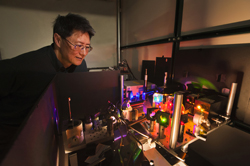ALBUQUERQUE, N.M. — The human eye is as comfortable with white light generated by diode lasers as with that produced by increasingly popular light-emitting diodes (LEDs), according to tests conceived at Sandia National Laboratories.
Both technologies pass electrical current through material to generate light, but the simpler LED emits lights only through spontaneous emission. Diode lasers bounce light back and forth internally before releasing it.
The finding is important because LEDs — widely accepted as more efficient and hardier replacements for century-old tungsten incandescent bulb technology — lose efficiency at electrical currents above 0.5 amps. However, the efficiency of a sister technology — the diode laser — improves at higher currents, providing even more light than LEDs at higher amperages.
“What we showed is that diode lasers are a worthy path to pursue for lighting,” said Sandia researcher Jeff Tsao, who proposed the comparative experiment. “Before these tests, our research in this direction was stopped before it could get started. The typical response was, ‘Are you kidding? The color rendering quality of white light produced by diode lasers would be terrible.’ So finally it seemed like, in order to go further, one really had to answer this very basic question first.”
Little research had been done on diode lasers for lighting because of a widespread assumption that human eyes would find laser-based white light unpleasant. It would comprise four extremely narrow-band wavelengths — blue, red, green, and yellow — and would be very different from sunlight, for example, which blends a wide spectrum of wavelengths with no gaps in between. Diode laser light is also ten times narrower than that emitted by LEDs.
The tests — a kind of high-tech market research — took place at the University of New Mexico’s Center for High Technology Materials. Forty volunteers were seated, one by one, before two near-identical scenes of fruit in bowls, housed in adjacent chambers. Each bowl was randomly illuminated by warm, cool, or neutral white LEDs, by a tungsten-filament incandescent light bulb, or by a combination of four lasers (blue, red, green, yellow) tuned so their combination produced a white light.
The experiment proceeded like an optometrist’s exam: the subjects were asked: Do you prefer the left picture, or the right? All right, how about now?
The viewers were not told which source provided the illumination. They were instructed merely to choose the lit scene with which they felt most comfortable. The pairs were presented in random order to ensure that neither sequence nor tester preconceptions played roles in subject choices, but only the lighting itself. The computer program was written, and the set created, by Alexander Neumann, a UNM doctoral student of CHTM director Steve Brueck.
Each participant, selected from a variety of age groups, was asked to choose 80 times between the two changing alternatives, a procedure that took ten to twenty minutes, said Sandia scientist Jonathan Wierer, who helped plan, calibrate and execute the experiments. Five results were excluded when the participants proved to be color-blind. The result was that there was a statistically significant preference for the diode-laser-based white light over the warm and cool LED-based white light, Wierer said, but no statistically significant preference between the diode-laser-based and either the neutral LED-based or incandescent white light.
The results probably won’t start a California gold rush of lighting fabricators into diode lasers, said Tsao, but they may open a formerly ignored line of research. Diode lasers are slightly more expensive to fabricate than LEDs because their substrates must have fewer defects than those used for LEDs. Still, he said, such substrates are likely to become more available in the future because they improve LED performance as well.
Also, while blue diode lasers have good enough performance that the automaker BMW is planning their use in its vehicles’ next-generation white headlights, performance of red diode lasers is not as good, and yellow and green have a ways to go before they are efficient enough for commercial lighting opportunities.
Still, says Tsao, a competition wouldn’t have to be all or nothing. Instead, he said, a cooperative approach might use blue and red diode lasers with yellow and green LEDs. Or blue diode lasers could be used to illuminate phosphors — the technique currently used by fluorescent lights and the current generation of LED-based white light — to create desirable shades of light.
The result makes possible still further efficiencies for the multibillion dollar lighting industry. The so-called ‘‘smart beams’’ can be adjusted on site for personalized color renderings for health reasons and, because they are directional, also can provide illumination precisely where it’s wanted.
Colorimetric and experimental guidance was provided by the National Institute of Standards and Technology.
The research was published in the July 1, Optics Express.
This work was conducted as part of the Solid-State Lighting Science Energy Frontier Research Center, funded by the U.S. DOE Office of Science.



